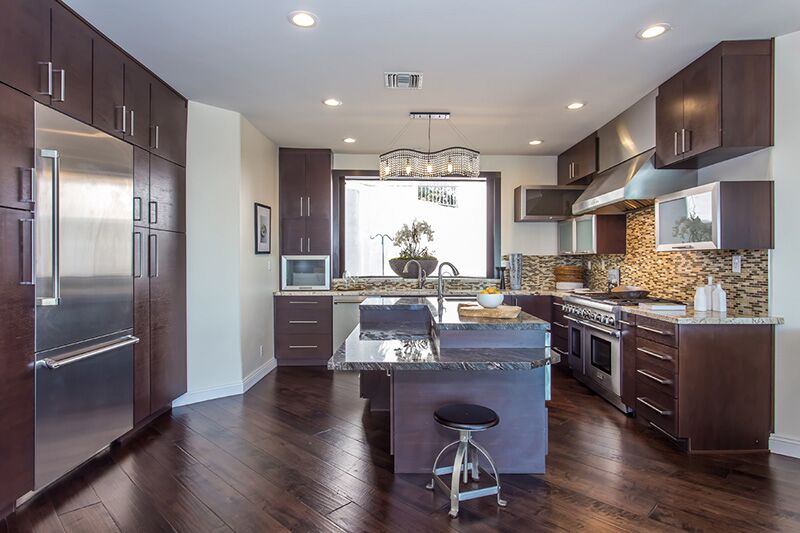8 Kitchen Remodeling Tips From the Pros

Creating a functional kitchen from the ground up isn't an easy task. Think about efficiency. Think about how you actually use the space. If people have all the room in the world—like when they're planning a kitchen in a new home—they think more is more. So they make the distance between the island and the counter-top broader. But that is not efficient. This kind of thinking often makes cooking and cleaning more difficult. Yes, you want your kitchen to feel open, airy, and inviting, but you don't want to have to walk 15 feet from your fridge to your range. But what's the best way to set it up?
A working triangle! The arrangement between the sink, the fridge, and the range should form an equilateral triangle if you map them out. When you're cooking, those are the three points of the kitchen you'll be repeatedly visiting, so it's best to have them more or less equidistant to each other. We always love to think about the view from either the range or the sink. If someone prefers to address their guests from the adjacent space while cooking, it’s best to place the range in a position where they can talk to people while they’re cooking. Same goes for somebody who imagines themselves spending more time at the sink. Then the triangle is planned from there.
Light Up Your Life
Lighting: one of the most important things to consider when renovating or building a new kitchen. While lots of people go with recessed lighting in their kitchen, we recommend surface-mount fixtures that are attached to your ceiling on a grid: "The bulb is below the height of the ceiling, so you get a more even light and it’s not as surgical as recessed lighting. It’s also very beautiful." And don't forget that cabinets can block light from falling onto your counter-tops. Planning for some under-cabinet lighting is important. Make sure you have a switch and some power outlets dedicated to that.
Your Stove Is Your Statement Piece
Your stove is the designer handbag of the kitchen. It's the most visible and the most used appliance. We believe that if you replace and upgrade only one thing in your kitchen, let your stove be that thing. Stoves come in a myriad of styles and colors, giving you a range of options. Also consider getting a hood for your range—an addition that'll help with ventilation and also make a statement.
In addition to thinking about your physical stove, you've got to think about the area around your stove, too. It's always good to have space on both sides of your range so you can have easy reach to prep and supplies.
Consider Your Countertops
Countertops need to be 24 or 25 inches, and it's best to have a little bit of an overhang, so dripping tomato sauce will fall onto your floor instead of onto your cabinets. Even aside from their function, counter-tops are a huge part of the kitchen, and they should align with your style. Solid surfacing like Corian is great. They can be repaired and they can be installed in such a way that no leftover food can be stuck in the seams. But when it comes to natural counter-tops, nothing compares to marble. It wears naturally, and there’s something beautiful about that because it’s a natural material. Hundred-year-old marble counters in an old Italian-villa kitchen—there’s nothing like that beauty. You can see, after 100 years, where people have been working on that counter.
Cabinet Positioning
Cabinets are just cabinets, right? Wrong! They're another opportunity to inject your style and make your cooking process more efficient. For example, you might want to forgo cabinet doors altogether. An open cabinet can quickly transform the spirit of your kitchen, making it more airy and interesting.
An exhaust hood for your range will help ventilate the kitchen while you're using it—a crucial function.
But what about your lower cabinets, underneath your counters? We recommend putting in at least two or three deep drawers for your pots and pans. Nothing gets stuck in the back if you can pull out a big stack of organized pans rather than crouching down, reaching back, and pulling it all out. It's just easier to load and unload. Another thing those deep drawers are good for? Garbage and recycling, which should go next to your sink.
Don't Get Just Any Old Flooring
We personally think that a stone floor is best for durability. But if you're a cook, it’s much more comfortable to stand on wood or Ipocork. With larger tiles, you have very few seams—a problem area that traps little bits of food that fall on the ground. And—get this—Italian porcelain tiles are really inexpensive. Score! If you can, while you’re at it, put a radiant tile heater under those tiles. Nothing like stepping on a slightly warm floor when you go to make your coffee in the morning.
Think About Sinks
We love sinks that are deep and broad. The most important part of your sink to think about, however, is your faucet. Having separate handles for hot and cold water is a real pain in the kitchen. You need to be able to flip back and forth really quickly, with a dirty pan in one of your hands. If you have a water-mixing valve in your faucet, you can do that in one motion.
And when you talk sinks, you've gotta talk dishwashers. Your dishwasher should be to the right of the sink because most people are right-handed. Obviously, if you're left-handed, switch up your dishwasher position for ease. You should also have counter space to the right of your sink. You know, so you don't have to balance that stack of dirty dishes, your pots and pans, and your delicate wine glasses all in your sink.
It All Comes Down to Survival
So what happens when you're renovating your kitchen—and can't access it for a month? If you've got a coffee maker, some nice linens, some silverware, and some plates, you can have coffee in the morning and order in at night—you'll hardly know you're missing anything. If the secret to surviving a kitchen renovation is takeout and fresh coffee, we can't wait to start.
